— by Mark Neil Reiter

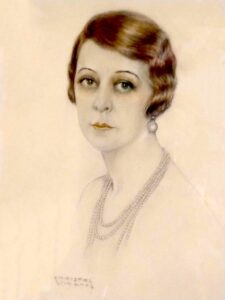
Christos Simatos had a significant career as the portrait artist for several European royal families, commissioned to capture their likenesses for posterity. One such family was the Royal Crown of Romania, specifically King Carol II [1893–1953], who assumed his title in 1930. The handsome King lived the life of a playboy. He sat for Simatos at least three times. In 1927, Carol first met Magda Lupescu [1896-1977]. Born in Hertza, a small Moldavian town, Magda was the daughter of a local Jewish pharmacist. She was famous for her unconventional beauty — flaming red hair, milky white skin, green eyes, curvaceous figure…and flirtatious demeanor. It didn’t take long before she became the King’s mistress. Meanwhile, he was on his 2nd marriage — to Princess Helen of Greece [1896-1982] — while Magda already had one divorce under her sash. (Helen — at left — sat for Simatos at least once.) This persuaded neither of these philanderers from carrying on a “private affair.” But after two years Carol could no longer contain himself and told his parents about his secret love (and that Helen disgusted him). When this hot news leaked, the Romanian populace universally reviled Magda. (Shades of Wallace Simpson and King Edward?) Due to her undue influence over the king, Magda had by 1927 become the target of The Iron Brigade, the Romanian National Guard, the overtly militant fascist movement. The King had set Magda up in a villa (pre-condominiums) near the Royal Palace — enjoying a wardrobe of Paris originals and $40,000 gold dinner plates — all paid for out of the Romanian treasury.
Then… Bang
The Iron Brigade was no joke. They took to using Magda’s head for target practice while she lollygagged in the garden of her villa. When she reported this most distressing breach of Royal etiquette to Carol, his eyes flashed Royal dudgeon. From that point on, the King suggested surrounding her villa with armed soldiers, and a police escort would now accompany her when she did her daily marketing. Magda reasoned that while that approach might be appropriate for a member of the court, the only title bestowed upon her was Chief Backseat Driver. But the power of this petticoat allowed for the resources of an infinitely more elaborate and expensive plan that Magda, herself, put into effect.
One can only imagine how this shrewd ruse popped into Lady Lupescu’s red head — perhaps inspired by the slapstick comedy of Hollywood’s Keystone Cops. Or a Greek tragedy? First, she assembled six, then twelve, “doubles” — lookalikes. She searched the Kingdom — high, and very low — to find twelve women who most closely resembled her in face and figure. Such details as the color of the hair, and the features and contours of the face are considered “malleable” — applied through the art and science of beautification.
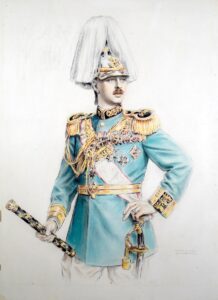
Carol was quite suspicious of this ploy. He had sought out his own look-alike — to protect himself from being the target of bomb throwers — but without success. Magda explained to the King that it was much harder to impersonate a man because the double must resemble the original very closely. There could be no “painting on” of facial features to produce a reasonable facsimile, the way a make-up artist could for women. (Of course, if the King had brought in Hollywood-type makeup/special effects artists it could have been possible. But such were the limits of his imagination.)
Crucial to this deception — and key to enticing a dozen women (surely of poorer means than Magda) — along with the risk of being blown to smithereens — was supplying them all with the exact same Paris wardrobe worn by Romania’s First Lady of Licentiousness. Imagine the bill for a full wardrobe of original designer outfits — times 12 — everything from day dresses to evening gowns, and fur coats, with every coordinating accessory. Magda kept strict records of her wardrobe so she could order her red-haired army to appear in public, on cue, pulling off a trick-of-the-eye — which on occasion fooled even the King. More than once, Magda’s in-palace spies reported that one of her doubles had fooled the King into engaging in hanky-panky — with the aid of the dimly lit passageways of the castle. And given that these 12 apt pupils were also schooled in imitating Magda’s caressing voice, and hip-swinging gait, this was bound to happen. As it was impossible for her to determine which one of her doubles had “double-crossed” her, Magda’s only option was to put her Chanel pump-clad foot down — informing the King that this “mistake” could not happen again.
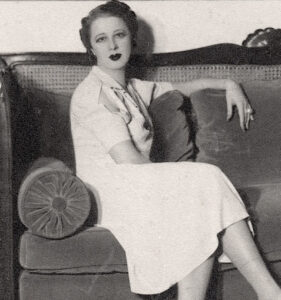
During the times when Magda’s interference with the political state was deemed too injurious to the power mongers, she let it be known that she was to flee to Poland. Several doubles were sent to the border, only to be captured, and then released once the Brigade realized their mistake. Then, Lupescu leaked rumors that she was headed for London. A trap was set at one of the railroad stations, and sure enough, at midnight, a coach rolled up, and out of it stepped a red-headed woman. But just as Lupescu’s enemies were about to seize her, along came another coach, with three red-headed women, and not one of them was Lupescu. During all the confusion she had deliberately put in motion, Lupescu put on a black wig and calmly rolled toward the frontier in a cheap motorcar — making her way to Paris.
Another time, it was reported that Magda was to appear in the middle of the afternoon, in streets full of traffic. This ruled out a kidnapping, so a plan was set for assassination. At the exact hour, an elegantly dressed woman appeared. As the killer waited for his victim to move into a position where he could not miss, he heard a warning signal from his co-conspirators. Glancing about, he was astonished to behold another Madame Lupescu, a carbon copy of the first. While hesitating as to whether to attempt to kill both, his jaw dropped at the vision of still a third Madame, right at the heels of the first two. Then a fourth appeared, followed by a fifth, sixth… and on and on… till the gunman looked like he had seen a ghost. It was said that the entire band of assassins got very drunk and then resigned in unison. It was most discouraging.
Dénouement
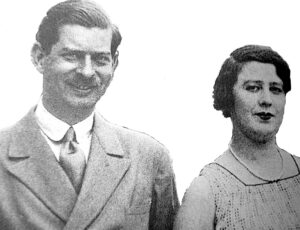
Ultimately, the King abdicated his throne. He and Magda fled the country for safer environs in Brazil — schlepping with them several hundred Louis Vuitton trunks filled with Royal treasures. Yes, they eventually married, in 1947. The New York Times reported that the former King finally married Magda after 23 years of companionship, but it was in a “death bed” ceremony after she had become gravely ill. The ceremony was performed in Carol’s suite at the Hotel Copacabana in Rio de Janeiro, Brazil, where they had lived since 1944. However, the couple soon moved to Estoril, Portugal, where Carol died in 1957. Magda outlived him by 24 years, passing away in 1977.
An appropriate postscript to the tale of Magda involves priceless jewels. There are several such “jeweled” stories — typical with the Royal families who were patrons of Christos Simatos:
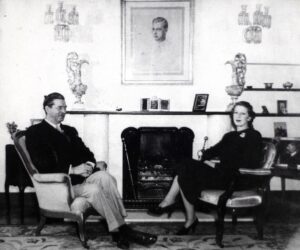
In the late 1920s, as an expression of his love for and devotion to Magda, King Carol gave her an exquisite pair of diamond and pearl drop earrings. In 1977, when Magda died, she bequeathed the earrings to an unnamed British woman she had befriended. When that lass passed on, she left them to her nephew, also unnamed. For 35 years the earrings sat in a drawer, until 2012, when the nephew, not expecting much, had them appraised. Because of their provenance and the near-perfect quality of the pearls, the earrings sold at auction for $2.7 million.
(Loud, Thunderous Applause… Slow Curtain… The End.)
There are eight million stories in “The Naked Archives.”
This has been one of them, painted by Christos Simatos.
— with apologies to “The Naked City” [1958–1963, ABC television series]
Source: The author credits source facts in this essay to Wikipedia as well as the article “Mme. Lupescu’s Dozen Red Headed Doubles” published online in The Esoterica Curiosa and written in 2012 by the woman known as Nash Rambler.
